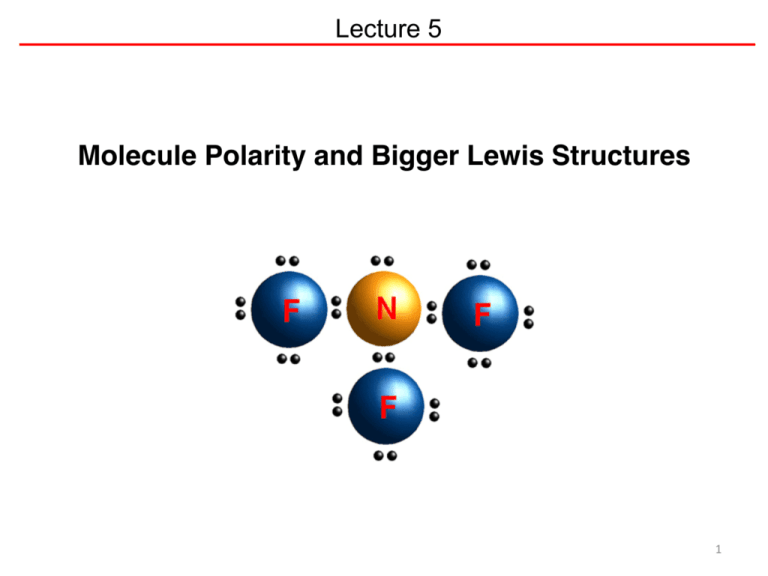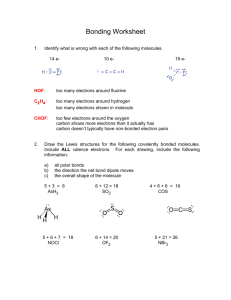Molecule Polarity and Bigger Lewis Structures
advertisement

Lecture 5 Molecule Polarity and Bigger Lewis Structures 1 VSEPR Valence Shell Electron Pair Repulsion • Each region of electrons (bond or lone pair) counts as a balloon • Balloons want to spread out as much as possible 2 Molecular Shapes 3 Polarity Covalent Bonds can be Polar or Nonpolar Polar molecules have different chemical properties than nonpolar X-Y Electronegativity difference 2 0.4 2 0.4 H-Cl + - Ionic Bond Polar Covalent Nonpolar Covalent 4 Molecule Polarity Will each of these molecules be polar? HCN CO2 H CH4 CH3F CH2F2 H F B B H H H CHF3 CF4 5 Lewis Structures Count Electrons Draw Skeleton Structure Form Double or Triple bonds to satisfy octet rule GREAT SUCCESS! No Yes Form bonds with 2 electrons Do all atoms have a full octet? Yes Fill Octet of TERMINAL atoms (only one bond) No Are all electrons used? Place remaining electrons on CENTRAL atoms 6 Lewis Structures Acetaldehyde CH3CHO Ethanol CH3CH2OH Group (example) Likely Position in Molecule Number of bonds 1 (H) Terminal 1 4 (C) Central 4 5 (N) Central 3 6 (O) Central or Terminal 2 7 (F) Central 1 ***Note that these bond number correspond with how many electrons are needed to gain an octet!*** 7 Lewis Structures Ethanol CH3CH2OH Acetaldehyde CH3CHO 8 Lewis Structures Alternate approach – start with sp3 hybridized Lewis Symbols (except H) and connect the dots. Ethanol CH3CH2OH Acetaldehyde CH3CHO 9 Lewis Structures – common groups 10 Lewis Structures CH3CH2CH2CH2CO2- CH3CH2NH3+ 11 Formal Charge CH3CH2NH3+ CH3CH2CH2CH2CO2- We can determine what atom is hosting the charge Electrons owned by atom (1 electron per covalent bond and 2 electrons per lone pair) Number of valence electrons for the neutral atom Formal Charge SO2 12




